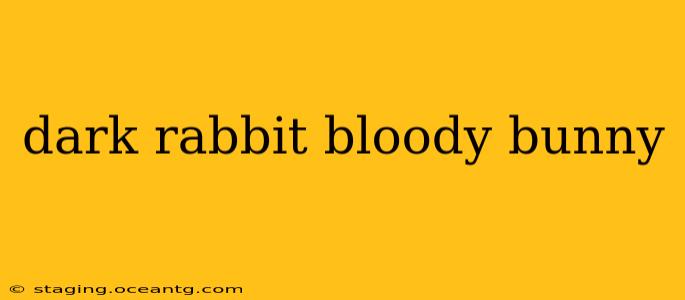Dark Rabbit, Bloody Bunny: Exploring the Symbolism and Interpretations
The phrases "dark rabbit" and "bloody bunny" evoke a potent blend of innocence and violence, darkness and light, making them compelling subjects for artistic, literary, and even psychological exploration. These phrases don't represent a single, universally understood meaning, but rather a complex tapestry of interpretations shaped by individual experiences and cultural contexts. This article delves into the multifaceted symbolism of these phrases, examining their appearances in various media and exploring the questions surrounding their meaning.
What does a dark rabbit symbolize?
The "dark rabbit" conjures images of mystery, shadow, and the hidden aspects of reality. Rabbits, traditionally associated with gentleness and fertility, take on a sinister twist when imbued with darkness. This contrast highlights the duality inherent in nature and in ourselves. The darkness might symbolize:
- The Shadow Self: In Jungian psychology, the shadow self represents the repressed or unconscious aspects of our personality. The dark rabbit could represent the darker, more primal urges we try to suppress.
- Hidden Knowledge or Secrets: Rabbits are sometimes associated with cunning and trickery, suggesting the dark rabbit may be a symbol of concealed knowledge or untold secrets.
- Fear and Anxiety: The darkness could represent the fear and anxiety associated with the unknown or the unpredictable. The rabbit, a typically harmless creature, becomes a harbinger of unease in its darkened form.
- Death and Decay: In some contexts, dark imagery is intrinsically linked to themes of death and decay. The dark rabbit could symbolize the end of innocence or a transition into a darker phase of life.
What does a bloody bunny symbolize?
"Bloody bunny," a far more explicit phrase, directly confronts the theme of violence and innocence lost. The image of a cute, innocent bunny covered in blood creates a powerful juxtaposition, evoking strong emotional responses. This symbolism can be interpreted in several ways:
- Violence and Innocence: The most straightforward interpretation is the stark contrast between the inherent cuteness of a bunny and the violence suggested by blood. This contrast emphasizes the brutal reality of violence and its impact on the innocent.
- Sacrifice and Redemption: In some religious or mythological contexts, blood can symbolize sacrifice and redemption. A bloody bunny could represent a sacrifice made to achieve a greater good, or a journey of redemption from innocence to experience.
- Trauma and Loss: The bloody bunny could also symbolize personal trauma or loss, representing the shattering of innocence and the pain of suffering. The blood signifies the wounds inflicted, both physical and emotional.
- Horror and the Grotesque: Within horror literature and art, the bloody bunny might be employed to shock and unsettle the viewer, using the cute imagery to amplify the grotesque nature of the violence.
Are dark rabbits and bloody bunnies connected to specific folklore or mythology?
While there isn't a single, established folklore tradition directly centered on "dark rabbits" or "bloody bunnies," these images tap into pre-existing archetypes and symbols found in various cultures. The rabbit itself appears in numerous mythologies, sometimes as a trickster figure, sometimes as a symbol of fertility and abundance. The addition of "dark" or "bloody" modifies these existing meanings, creating something new and unsettling. The use of these terms often appears in contemporary horror, fantasy, and art, building on established symbols and adding a fresh layer of interpretation.
How are dark rabbits and bloody bunnies used in popular culture?
These phrases and imagery appear frequently in various forms of popular culture, primarily in horror, fantasy, and darker forms of art. They are used to create a sense of unease, to explore themes of violence and innocence, and to challenge viewers' expectations. The ambiguity inherent in these images allows for a wide range of interpretations, depending on the context in which they are used.
In conclusion, the meanings of "dark rabbit" and "bloody bunny" are subjective and deeply influenced by individual and cultural contexts. While there's no single, definitive interpretation, the power of these phrases lies in their ability to evoke strong emotions and prompt reflection on themes of innocence, violence, and the darker aspects of human nature. Their appearance in various media underscores their lasting symbolic impact and adaptability within evolving artistic and cultural landscapes.
